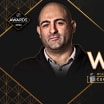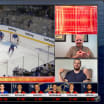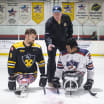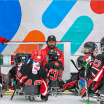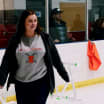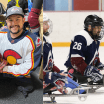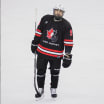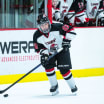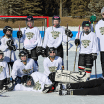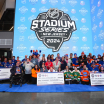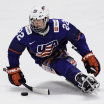WATERTOWN, Mass. -- As Mike Bolt stationed the Stanley Cup's carrying case outside on a walkway, ready for the revered trophy to be unveiled for some TV cameras, a student walked by. The child, who attends Perkins School for the Blind in suburban Boston, was asked if he wanted to feel the Cup, to get a sense of it with his fingers.
He was thrilled as he ran his fingers along the names of players and staff who have lifted the Stanley Cup, each one individually punched into the silver. His hands ran along the bowl where so many champions have eaten cereal or sat their babies or tossed in a soda.
He was in awe.
"Is it heavy?" he asked.
On April 13, the Stanley Cup made its second trip to Perkins. It first visited after the Boston Bruins 2011 championship, on the day former strength and conditioning coach John Whitesides had with the vaunted trophy. Now, on this warm spring day, the students and teachers at the school gathered to listen and ask questions to Bolt, one of the keepers of the Cup, who works for the Hockey Hall of Fame and travels the world with it.
They also were able to, most importantly, get a feel for what the Cup means, literally and figuratively.
"All the other major sports trophies, they don't even let you touch it," Bolt said. "My rule is, you can hug it, you can kiss it. If you feel the need to lift it, go win it. But that's the great thing. They really got to put their hands all over it. It's not quite Braille (a system of raised dots that can be read with the fingers by people who are blind or who have low vision, according to the American Foundation for the Blind), but you can kind of feel the names because each name is actually hand-punched in on the Cup.
"Just seeing the joy and excitement it brought to a lot of the kids, watching the facial expressions. And that's the one part of my job, wherever I am, the reaction and the joy that it brings to so many people never gets old."
The room was filled with students and their teachers -- usually in a 1-to-1 ratio -- with many of them wearing Bruins shirts or jerseys, featuring the names of Brad Marchand, Patrice Bergeron and David Pastrnak. Perkins, founded in 1829 as the first school in the United States for people who are blind, has students from preschool until their transition age, which is generally 22.
"I'm kind of speechless right now," said Kyle Butt, 17, a student at Perkins from Swampscott. "It was unreal. I thought it was a dream. It's a dream come true."
"I thought it was going to be heavier," Butt said. "The way the guys lift it, they usually struggle to lift it at first. Maybe that's just because they're tired from winning the Cup. I just always thought it was very heavy, but it's only 37 pounds; which, coincidentally is Bergeron's number."
He predicted that the Bruins would go 16-0 in the Stanley Cup Playoffs to win the Cup.
As Bolt spoke to the students and answered questions, one child in the back jumped in, letting Bolt know that he didn't need to go anywhere, that he and the Cup could stay, in anticipation of the Presidents' Trophy-winning Bruins winning it this season.
For the visit, Perkins was provided with Bruins playoff pucks to which they added Braille lettering, spelling out Stanley Cup Playoffs.
But it wasn't just the students who were in awe. The teachers were too.
Jeff Migliozzi, who has been a teacher of English, health, sex education and media at the school for almost 40 years, and who is blind himself, is a longtime hockey and Bruins fan, despite growing up in New Jersey.
"Bobby Orr captured my imagination when I was a kid," Migliozzi said. "One of the first things I did when I moved to Boston permanently was go see the Bruins. I've been a lifelong fan."
While most of the students reveled in getting to touch the Cup, Migliozzi wasn't among them. He declined to touch it, citing the superstition that people are not supposed to touch the hallowed trophy until they win it. But for the kids who did, he said it's hard to understate the importance of the experience.
"You just don't know visually -- some kids might think it's a little cup, some kids might think it's the size of a swimming pool," Migliozzi said. "You don't have that concept development. So being able to actually physically understand just how big it is, how it's shaped and that kind of stuff, is hugely important."
While this was only the Cup's second trip to Perkins, the Bruins are not strangers at the campus. Players typically come every year to learn how to play goalball, a sport designed for the visually impaired in which they must roll a basketball-sized ball filled with bells over a goal line. Donning goggles that black out their vision, Pavel Zacha and Tomas Nosek played goalball in December, and Marchand and former Bruins players Zdeno Chara and Jarome Iginla have visited in the past.
"Our kids are so excited to have the Cup here, for it to finally be here," said Megan O'Connell-Copp, a teacher of adaptive physical education at Perkins for 12 years.
"They've been talking about it nonstop. … To be able to actually have hands on the Cup, that's their way to see the Cup. That's their way to see what everyone else can look at and see.
"For our students, it's access to be able to understand what the Cup is, how big it is, how tall it is. Pretty exciting, pretty special moment for our students."
